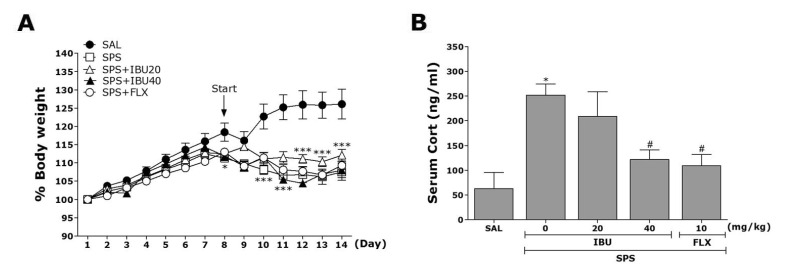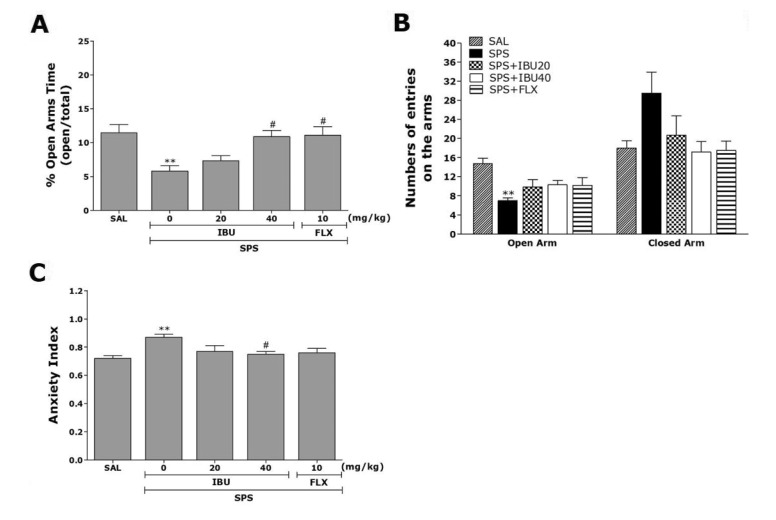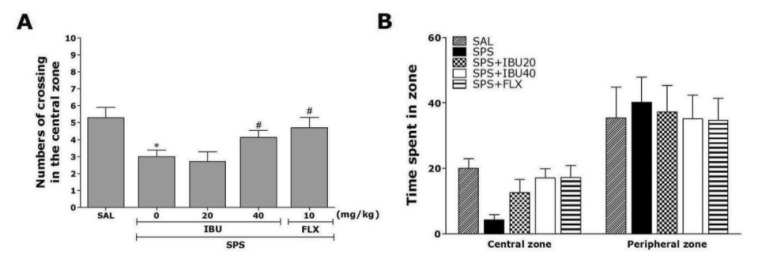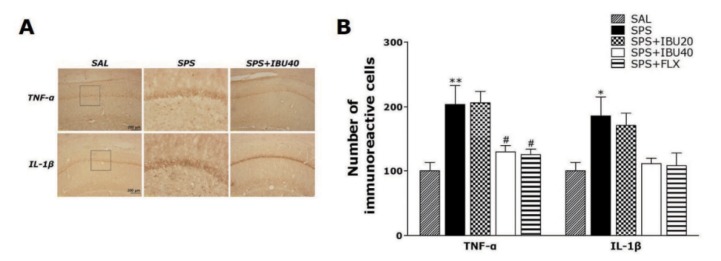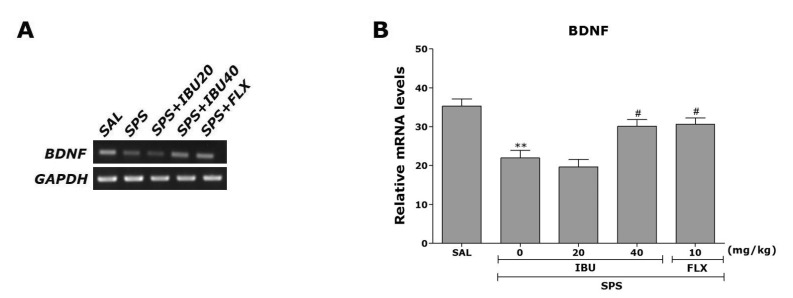Korean J Physiol Pharmacol.
2016 Jul;20(4):357-366. 10.4196/kjpp.2016.20.4.357.
Effects of systemic administration of ibuprofen on stress response in a rat model of post-traumatic stress disorder
- Affiliations
-
- 1Acupuncture and Meridian Science Research Center, College of Korean Medicine, Kyung Hee University, Seoul 02447, Korea. bombi@khu.ac.kr, dhhahm@khu.ac.kr
- 2The Graduate School of Basic Science of Korean Medicine, College of Korean Medicine, Kyung Hee University, Seoul 02447, Korea.
- KMID: 2371053
- DOI: http://doi.org/10.4196/kjpp.2016.20.4.357
Abstract
- Pro-inflammatory cytokine and brain-derived neurotrophic factor (BDNF) are modulated in post-traumatic stress disorder (PTSD). This study investigated the effects of ibuprofen (IBU) on enhanced anxiety in a rat model of PTSD induced by a single prolonged stress (SPS) procedure. The effects of IBU on inflammation and BDNF modulation in the hippocampus and the mechanisms underlying for anxiolytic action of IBU were also investigated. Male Sprague-Dawley rats were given IBU (20 or 40 mg/kg, i.p., once daily) for 14 days. Daily IBU (40 mg/kg) administration signifi cantly increased the number and duration of open arm visits in the elevated plus maze (EPM) test, reduced the anxiety index in the EPM test, and increased the time spent in the center of an open fi eld after SPS. IBU administration signifi cantly decreased the expression of pro-inflammatory mediators, such as tumor necrosis factor-α, interleukin-1β, and BDNF, in the hippocampus, as assessed by reverse transcription-polymerase chain reaction analysis and immunohistochemistry. These fi ndings suggest that IBU exerts a therapeutic effect on PTSD that might be at least partially mediated by alleviation of anxiety symptoms due to its anti-inflammatory activity and BDNF expression in the rat brain.
MeSH Terms
Figure
Cited by 1 articles
-
Tetramethylpyrazine reverses anxiety-like behaviors in a rat model of post-traumatic stress disorder
Bombi Lee, Insop Shim, Hyejung Lee, Dae-Hyun Hahm
Korean J Physiol Pharmacol. 2018;22(5):525-538. doi: 10.4196/kjpp.2018.22.5.525.
Reference
-
1. Zhang LM, Zhou WW, Ji YJ, Li Y, Zhao N, Chen HX, Xue R, Mei XG, Zhang YZ, Wang HL, Li YF. Anxiolytic effects of ketamine in animal models of posttraumatic stress disorder. Psychopharmacology (Berl). 2015; 232:663–672. PMID: 25231918.
Article2. Brunello N, Davidson JR, Deahl M, Kessler RC, Mendlewicz J, Racagni G, Shalev AY, Zohar J. Posttraumatic stress disorder: diagnosis and epidemiology, comorbidity and social consequences, biology and treatment. Neuropsychobiology. 2001; 43:150–162. PMID: 11287794.
Article3. Nemeroff CB, Bremner JD, Foa EB, Mayberg HS, North CS, Stein MB. Posttraumatic stress disorder: a state-of-the-science review. J Psychiatr Res. 2006; 40:1–21. PMID: 16242154.
Article4. Ji MH, Jia M, Zhang MQ, Liu WX, Xie ZC, Wang ZY, Yang JJ. Dexmedetomidine alleviates anxiety-like behaviors and cognitive impairments in a rat model of post-traumatic stress disorder. Prog Neuropsychopharmacol Biol Psychiatry. 2014; 54:284–288. PMID: 25004167.
Article5. Rau V, DeCola JP, Fanselow MS. Stress-induced enhancement of fear learning: an animal model of posttraumatic stress disorder. Neurosci Biobehav Rev. 2005; 29:1207–1223. PMID: 16095698.
Article6. Liberzon I, López JF, Flagel SB, Vázquez DM, Young EA. Differential regulation of hippocampal glucocorticoid receptors mRNA and fast feedback: relevance to post-traumatic stress disorder. J Neuroendocrinol. 1999; 11:11–17. PMID: 9918224.
Article7. Nie H, Peng Z, Lao N, Wang H, Chen Y, Fang Z, Hou W, Gao F, Li X, Xiong L, Tan Q. Rosmarinic acid ameliorates PTSD-like symptoms in a rat model and promotes cell proliferation in the hippocampus. Prog Neuropsychopharmacol Biol Psychiatry. 2014; 51:16–22. PMID: 24418162.
Article8. de Souza CO, Kurauti MA, de Fatima Silva F, de Morais H, Borba-Murad GR, de Andrade FG, de Souza HM. Effects of celecoxib and ibuprofen on metabolic disorders induced by Walker-256 tumor in rats. Mol Cell Biochem. 2015; 399:237–246. PMID: 25359170.
Article9. Antezana DF, Clatterbuck RE, Alkayed NJ, Murphy SJ, Anderson LG, Frazier J, Hurn PD, Traystman RJ, Tamargo RJ. High-dose ibuprofen for reduction of striatal infarcts during middle cerebral artery occlusion in rats. J Neurosurg. 2003; 98:860–866. PMID: 12691413.
Article10. Zara S, De Colli M, Rapino M, Pacella S, Nasuti C, Sozio P, Di Stefano A, Cataldi A. Ibuprofen and lipoic acid conjugate neuroprotective activity is mediated by Ngb/Akt intracellular signaling pathway in Alzheimer's disease rat model. Gerontology. 2013; 59:250–260. PMID: 23428737.
Article11. Pace TW, Heim CM. A short review on the psychoneuroimmunology of posttraumatic stress disorder: from risk factors to medical comorbidities. Brain Behav Immun. 2011; 25:6–13. PMID: 20934505.
Article12. Hoge EA, Brandstetter K, Moshier S, Pollack MH, Wong KK, Simon NM. Broad spectrum of cytokine abnormalities in panic disorder and posttraumatic stress disorder. Depress Anxiety. 2009; 26:447–455. PMID: 19319993.
Article13. Jones KA, Thomsen C. The role of the innate immune system in psychiatric disorders. Mol Cell Neurosci. 2013; 53:52–62. PMID: 23064447.
Article14. von Känel R, Hepp U, Kraemer B, Traber R, Keel M, Mica L, Schnyder U. Evidence for low-grade systemic proinflammatory activity in patients with posttraumatic stress disorder. J Psychiatr Res. 2007; 41:744–752. PMID: 16901505.
Article15. Hoffman JR, Ostfeld I, Stout JR, Harris RC, Kaplan Z, Cohen H. β-Alanine supplemented diets enhance behavioral resilience to stress exposure in an animal model of PTSD. Amino Acids. 2015; 47:1247–1257. PMID: 25758106.
Article16. Tyagi E, Agrawal R, Zhuang Y, Abad C, Waschek JA, Gomez-Pinilla F. Vulnerability imposed by diet and brain trauma for anxiety-like phenotype: implications for post-traumatic stress disorders. PLoS One. 2013; 8:e57945. PMID: 23483949.
Article17. Dotta-Panichi RM, Bins HD, Tramontina JF, Ceresér KM, Aguiar BW, Paz AC, Taborda JG. Serum concentrations of brain-derived neurotrophic factor and mental disorders in imprisoned women. Rev Bras Psiquiatr. 2015; 37:113–120. PMID: 25714755.
Article18. Yamamoto S, Morinobu S, Fuchikami M, Kurata A, Kozuru T, Yamawaki S. Effects of single prolonged stress and D-cycloserine on contextual fear extinction and hippocampal NMDA receptor expression in a rat model of PTSD. Neuropsychopharmacology. 2008; 33:2108–2116. PMID: 17957211.
Article19. Serova LI, Laukova M, Alaluf LG, Pucillo L, Sabban EL. Intranasal neuropeptide Y reverses anxiety and depressive-like behavior impaired by single prolonged stress PTSD model. Eur Neuropsychopharmacol. 2014; 24:142–147. PMID: 24326087.
Article20. Wixey JA, Reinebrant HE, Buller KM. Post-insult ibuprofen treatment attenuates damage to the serotonergic system after hypoxia-ischemia in the immature rat brain. J Neuropathol Exp Neurol. 2012; 71:1137–1148. PMID: 23147509.
Article21. Serova LI, Tillinger A, Alaluf LG, Laukova M, Keegan K, Sabban EL. Single intranasal neuropeptide Y infusion attenuates development of PTSD-like symptoms to traumatic stress in rats. Neuroscience. 2013; 236:298–312. PMID: 23376740.
Article22. Sudakov SK, Nazarova GA, Alekseeva EV, Bashkatova VG. Estimation of the level of anxiety in rats: differences in results of open-field test, elevated plus-maze test, and Vogel's conflict test. Bull Exp Biol Med. 2013; 155:295–297. PMID: 24137586.
Article23. Paxinos G, Watson C. The rat brain in stereotaxic coordinates. 3th ed. New York: Academic Press;1986. p. 54–85.24. Patki G, Li L, Allam F, Solanki N, Dao AT, Alkadhi K, Salim S. Moderate treadmill exercise rescues anxiety and depression-like behavior as well as memory impairment in a rat model of posttraumatic stress disorder. Physiol Behav. 2014; 130:47–53. PMID: 24657739.
Article25. Juven-Wetzler A, Cohen H, Kaplan Z, Kohen A, Porat O, Zohar J. Immediate ketamine treatment does not prevent posttraumatic stress responses in an animal model for PTSD. Eur Neuropsychopharmacol. 2014; 24:469–479. PMID: 24239430.
Article26. Shang L, Xu TL, Li F, Su J, Li WG. Temporal dynamics of anxiety phenotypes in a dental pulp injury model. Mol Pain. 2015; 11:40–57. PMID: 26122003.
Article27. Lee B, Sur B, Yeom M, Shim I, Lee H, Hahm DH. L-tetrahydropalmatine ameliorates development of anxiety and depression-related symptoms induced by single prolonged stress in rats. Biomol Ther (Seoul). 2014; 22:213–222. PMID: 25009702.28. Acosta SA, Diamond DM, Wolfe S, Tajiri N, Shinozuka K, Ishikawa H, Hernandez DG, Sanberg PR, Kaneko Y, Borlongan CV. Influence of post-traumatic stress disorder on neuroinflammation and cell proliferation in a rat model of traumatic brain injury. PLoS One. 2013; 8:e81585. PMID: 24349091.
Article29. Peng Z, Wang H, Zhang R, Chen Y, Xue F, Nie H, Chen Y, Wu D, Wang Y, Wang H, Tan Q. Gastrodin ameliorates anxiety-like behaviors and inhibits IL-1beta level and p38 MAPK phosphorylation of hippocampus in the rat model of posttraumatic stress disorder. Physiol Res. 2013; 62:537–545. PMID: 24020812.
- Full Text Links
- Actions
-
Cited
- CITED
-
- Close
- Share
- Similar articles
-
- Post-Traumatic Stress Disorder, Depression and Anxiety among North Korean Refugees: A Meta-Analysis
- Post-Traumatic stress disorder
- Posttraumatic Stress Disorder in Firefighters
- Cognitive Emotion Regulation Strategies in Post-Traumatic Stress Disorder
- Effects of Nurses' Workplace Violence Experiences on Post-Traumatic Stress Disorder: Focusing on the Moderating Effect of Resilience and Social Support at Work


